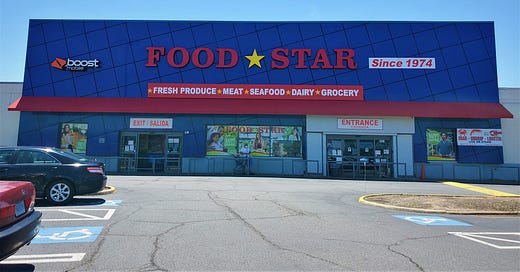A few days back, I wrote an illustrated post about a former Giant supermarket in Herndon, Virginia, which became an H-Mart (a Korean-focused supermarket chain) in late 2018. I noted that Giant is currently remodeling stores with the interior décor package this former location has, but H-Mart has mostly left the interior alone. What that means is that, exactly because it fell out of the chain, a piece of chain-specific branding is being preserved. I find that interesting. It’s often how older models of chain restaurants get preserved as well. Chains themselves tend to value conformism over history, rarely seeing decades of architectural and design variety as an asset. Consider McDonald’s, which is totally demolishing and rebuilding many of its older locations. I find that sad.
The Giant/H-Mart is also interesting for how the space was adapted, without a gutting or total remodeling, for the preferences and expectations of a Korean-heavy customer base. For example, the Giant fish counter was too small, and is now used perfunctorily for prepackaged foods. The pharmacy became a much larger fish counter. The prep space behind the slicing deli became a seating area for a small, narrow food court. The Giant décor remains, such as the backsplash tiles in those departments, and much of the hanging signage. It’s an interplay of old and new, an incremental refashioning of what already exists, for slightly different purposes than intended originally. It’s almost like a microcosm of a city.
Today, however, I’m looking at a “secondhand supermarket” of a different nature. This is Food Star, in Bailey’s Crossroads, Virginia, a bit southeast of Falls Church.
Unlike the Giant/H-Mart, you may guess, correctly, that this did not begin life as a supermarket. The exterior, unchanged except for the store name and a removed yellow plastic border around the entrance, is a Toys ‘R’ Us façade. My best guess is it’s from the ’80s. It would have looked just like the photo here when it was still in business.
The building, of course, is secondhand for the Food Star. That’s less interesting than the H-Mart, because a box store like Toys ‘R’ Us lacks the nooks and crannies and distinct departments of a supermarket. The interesting thing here is not the use or adaptation of interior space. Rather, it’s what these pictures show. Keep in mind this store has only been open since early 2020.
Do those fixtures look new? Do they match? Nope. Notice the islands and freezer cases have different designs and color schemes. Most likely, they are all identifiable as having once belonged to a particular supermarket chain. Do you happen to recognize any?
But most interesting is that they’re used. This is a new supermarket assembled out of used supermarket fixtures, from a variety of different original owners, presumably stored in a huge warehouse waiting for tenants like this who don’t mind a few dents and scratches. Generally new stores in old buildings either use existing fixtures, as in the Giant/H-Mart, or they bring in new ones. This is not something I’ve ever seen—or noticed—before. However, it makes lots of sense, because big chains routinely replace old but working fixtures as part of remodels or upgrades. Smaller, budget-oriented chains (there’s only one other Food Star) or independent stores, with small or nonexistent branding and décor concerns, are an obvious buyer.
I’m curious where exactly these used parts come from: an auction, a distributor, etc.? Does anyone have any knowledge of this? Who knew a scratched up freezer case in a former Toys ‘R’ Us would make me aware of a new, and probably rather large, secondhand market!
Related Reading:









I believe this Food Star replaced the one once located at the intersection of George Mason Drive and Columbia Pike in Arlington. Perhaps the interior of the old location was put in storage until the new location was found? That store also had odd roots -- it was an A&P until the early 80s and was briefly a Super Fresh before becoming a Food Star, IIRC.